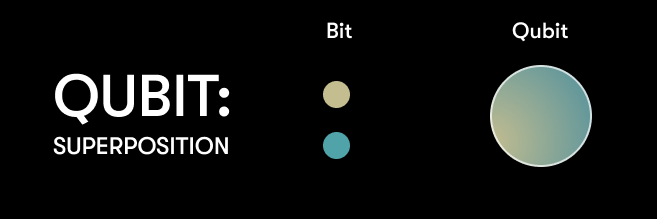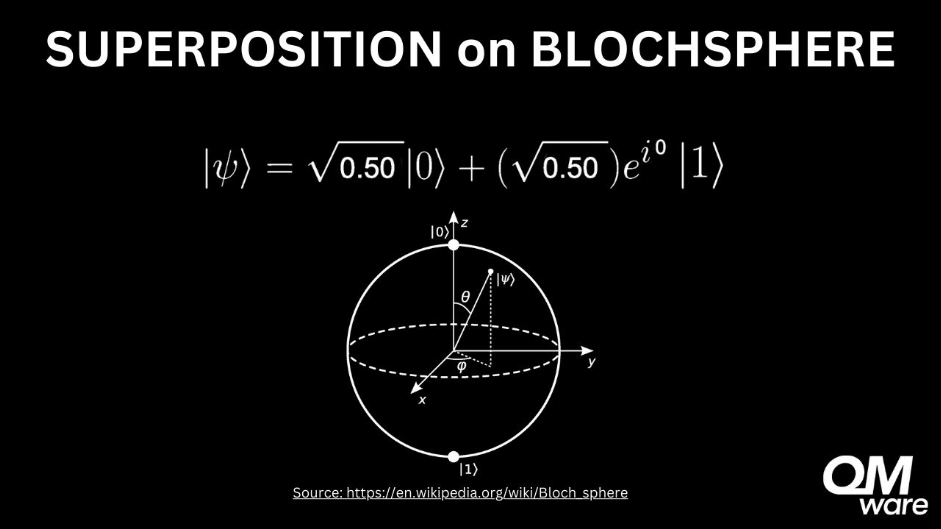What is Quantum Superposition?
Superposition Definition
A key distinction between a classical bit and a quantum bit (qubit) is the ability of the qubit to exist in superposition states. In other words, a qubit can exist in a linear combination of basis states |0⟩ and |1⟩, which we also describe as computational states. A general qubit state can thus be expressed as |ψ⟩ = α|0⟩ + β|1⟩, which is a superposition of ∣0⟩ and ∣1⟩ with complex amplitudes α and β.

Traditional computers use Bits that can be either 0 or 1, but not both at once. Quantum computers, on the other hand, use Qubits which can be in a linear combination of 0 and 1, a phenomenon known as ‘Superposition’. Unlike Bits, Qubits can exist anywhere on a sphere, as shown in the image above.
A key distinction between a classical bit and a quantum bit (qubit) is the ability of the qubit to exist in superposition states. In other words, a qubit can exist in a linear combination of basis states |0⟩ and |1⟩, which we also describe as computational states. A general qubit state can thus be expressed as
|ψ⟩ = α|0⟩ + β|1⟩,
which is a superposition of ∣0⟩ and ∣1⟩ with complex amplitudes α and β.
When a larger quantum system composed of multiple qubits is in a superposition |ψ >= α1∣000…0⟩ + α2∣000…1⟩ + … + α2^n∣111…1⟩ of its composite basis states, it can perform calculations on all possible combinations of its qubits at once. As a result, quantum computers can process many possibilities in parallel and potentially solve certain types of problems much more efficiently than classical computers. This is evident in Shor’s Algorithm, where the speedup comes from the application of the quantum Fourier transform, which is a key part of the algorithm and exploits the principle of superposition.
Superposition Notation & Measurement
Contrary to classical physics, in quantum mechanics, the outcome of a measurement is governed by probabilities and randomness. This means that for a qubit in a state of superposition |ψ⟩, one can only predict the probabilities of outcomes for repeated measurements on a large number of copies of the same qubit. However, the measurement outcome of one individual measurement is entirely random and can be either |0⟩ or |1⟩. This is also the reason why, in quantum computing, we currently have to carry out several so-called shots, or executions, of the same circuit in order to get a meaningful result. We will explore quantum circuits in more depth later in another blog article.
When measuring a qubit, the superposition collapses into one of the basis states, corresponding to the particular basis we are measuring in, generally the computational basis |0⟩ and |1⟩.
Let’s consider a qubit in the general superposition state from above, represented as |ψ⟩ = α|0⟩ + β|1⟩, where α and β are complex numbers. As mentioned in our article “From bits to qubits”, the probabilities of measuring |0⟩ or |1⟩ are given by the squares of the absolute values of α and β, respectively. That is, P(0) = |α|^2 and P(1) = |β|^2.
However, we can choose to measure the qubit with respect to any other basis, e.g. |+⟩ = 1/√2|0⟩ + 1/√2|1⟩ and |-⟩ = 1/√2|0⟩ – 1/√2|1⟩, and the probabilities to obtain either outcome, |+⟩ or |-⟩, as a result of the measurement will change accordingly. For example, in an equal superposition state (|ψ⟩ = 1/√2|0⟩ + 1/√2|1⟩) the probabilities of measuring |0⟩ or |1⟩ are both P(0)=P(1)=50% if we measure in the computational basis; however, the probability of measuring in the |+⟩, |-⟩ basis are P(+) = 100% and P(-) = 0%.

It is important to not confuse a genuine quantum superposition with a probabilistic classical state, such as a tossed coin. The physics of the tossed coin is essentially deterministic and the probability of coming up heads or tails is 50% each due to lack of knowledge of parameters such as the tossing angle, throwing speed, etc. However, these parameters can in principle be known, and if we knew all the initial parameters of the coin at the moment of the toss, we could make a prediction (using the laws of classical physics) at which point during the toss the flipping coin would show heads or tails.
However, for the qubit in a genuine quantum superposition, even if we know every parameter there is to know about the qubit’s state, an individual measurement outcome is completely random. We can only derive the probabilities of outcomes for repeated measurements on a large number of copies of the qubit.
Superposition on the Bloch Sphere
The Bloch sphere visualizes quantum states of a qubit using a unit sphere, where each point corresponds to a unique state— the north pole is usually for |0⟩ and south pole for |1⟩. A superposition state of a qubit is visually represented as a point on the sphere’s surface. The exact coordinates of the point represent the probability amplitudes of measuring each state and the phase difference between them. In the Bloch sphere picture, the qubit state is parametrized by two real numbers, θ and φ:
|ψ⟩ = cos(θ/2)|0⟩ + e^iφ sin(θ/2)|1⟩
For example, if a qubit is in an equal superposition state (|+⟩ = 1/√2|0⟩ + 1/√2|1⟩), it would be represented by a point on the equator of the Bloch sphere where θ and φ take the values θ= and φ=0. If we want to depict the |-⟩ state on the Bloch sphere, the values would be θ=π/2 and φ=π.

References:
[1] Nielsen, Michael A., and Isaac L. Chuang. 2012. “Quantum Computation and Quantum Information.” Cambridge University Press. https://doi.org/10.1017/cbo9780511976667.